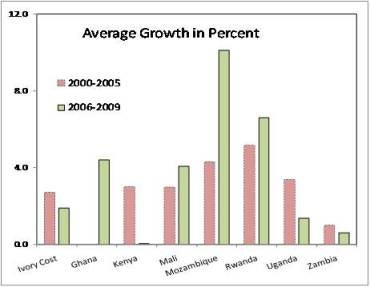Rwanda’s economy is growing at a healthy rate--7.5 percent in 2010, two percent higher than the East African Community (EAC) and even more than Sub Saharan Africa (SSA).
During 2010, the services and industrial sectors progressed in their recovery, while growth in the agricultural sector slowed down marginally. The country’s macroeconomic framework was remarkably stable, given the difficult external post-crisis environment and Rwanda’s position as a highly import-dependent, land-locked country. This was mainly achieved through a prudent fiscal stance with strong focus on priority expenditures, assisted by continued grant financing from donors.
Click on the graphs to see them bigger
Rwanda’s projected growth rate for 2011 is 7.0 percent, significantly higher than the 5.5 percent predicted for SSA or the 5.9 percent predicted for the EAC. All sectors are likely to grow at comparable pre-crisis levels again, but there is reason for caution. The first 2011 harvest was disappointing, and agriculture growth might turn out to be moderate. Services growth might be less as high Government spending for health, education and other services is returning to pre-crisis levels.
Manufacturing remains in the midst of recovery. Leading indicators for growth, like credit to the private sector, performed less well than expected, as did growth in the construction sub-sector. Interest rates remain high. The outlook remains dependent on effects of increasing international fuel and food prices. The balance of payment continues to be vulnerable to export shocks, due to the dependence on a few export products
Agriculture continues to contribute to growth in Rwanda, despite the emergence of other significant growth drivers, such as services due to its large employment weight (see graph below). Featured as the special topic of the recently newly launched World Bank Rwanda Economic Update, agriculture triggered a lively discussion in the press in the following week.
Rwanda’s focus on agriculture, through continued public investments, has contributed to marked productivity increases and solid agriculture growth rates over recent years. Land productivity increased dramatically. The country is leading compared to other African countries with similar GDP shares of agriculture (see graph below).
The relatively high level of land productivity reflects the favorable agro-climatic potential resulting in two harvest seasons, as well as the intensive nature of the predominant agricultural production systems. In contrast, labor productivity remains low compared to these countries, albeit increasing over the last decade. This is related to the fact that Rwanda has the highest proportion of rural population, most of them engaged in labor intensive agriculture. It appears that most opportunities for future productivity gains lie in the area of making agricultural production less labor intensive, in other words less subsistence based.
In comparison to other African countries Rwanda’s agricultural growth is high…
… but labor productivity remains low...
… as is land productivity…
In order to sustain these productivity increases in the future, and in order to fully realize the growth potential for the agriculture sector, a number of challenges would need to be addressed, including:
- Reducing dependency on rain-fed agriculture through greater use of different models of irrigation;
- Better erosion control and integrated soil fertility management;
- Diversifying agriculture production, in particular agricultural export goods, for example in areas of horticulture and flowers,
- Changing the skills profile of people employed in agriculture, to foster the creation of off-farm employment such as agro-processing and other value chain activities, and
- Better post-harvest management, including developing a market-based food crop distribution system to contribute to country-wide food security. Continued agriculture growth through the channels outlined above will benefit agriculture growth and increase food security, but most of all will sow the seeds for higher overall economic activity.







Join the Conversation